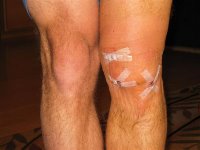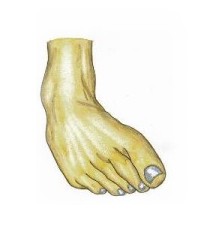Obama or Clinton, Who Has the Better Warrior Posture?
 There you have it. Hers is the better warrior pose. He, well, he's not so comfortable in that posture.
There you have it. Hers is the better warrior pose. He, well, he's not so comfortable in that posture.Those are the words of Michelle Norris, a host on the NPR news program All Things Considered. She made those remarks this morning on the NBC show Meet the Press.
 The "he" to whom she refers is Sen. Barack Obama. "She" is Sen. Hillary Clinton. Both are seeking the nomination of the Democrat party to be President of the United States.
The "he" to whom she refers is Sen. Barack Obama. "She" is Sen. Hillary Clinton. Both are seeking the nomination of the Democrat party to be President of the United States.Norris, Tim Russert, Chuck Todd, and the other commentators on the show were talking about the recent Clinton charge against Obama that he is a plagiarist, that he steals the most effective lines he uses on the campaign trail.
Russert, the host of Meet the Press, showed a variety of video clips and quotes that proved that seemingly all who run for high office borrow heavily from the phrases and patterns of speech of others who have run before them. Even Hillary borrows from Bill Clinton's old stump speeches.
So why is the Clinton camp pointing the finger at Obama when both use others' words? Norris and Todd say it's because she was trying to draw him out.
It's a taunt. She's goading him into a fight, a war, that she thinks she can win.
Norris went on to say that as long as he acts authentically, in fidelity with his true nature, Sen. Obama seems to attract more support for his candidacy. By attacking his ego and portraying him as a cheater, others hope to draw him into playing an adopted role and then defeat him at the game of putting on the best persona. "To thine own self be true," comes to mind.
There's another layer of irony here, too. It's the job for which they're running. President of the United States of America. Commander in Chief.
A major role of the President is that of top military commander. The President is the supreme warrior, and commander of warriors, in the United States.
It might seem that picking a fight proves your credentials, your readiness to lead in battle. Conversely, backing down from a fight might indicate that you're not ready to "assume the position" of top military leader.
Obama addressed that in a recent debate. He said that in opposing the war in Iraq he "showed the judgment of a commander in chief."
Could it be that the greatest military leader is the one who is most reluctant to engage in violent war-making? Maybe his warrior position is better after all.
Non-harming (ahimsa) is an imperative in Patanjali's classical system of yoga (Raja Yoga). I live in a world so permeated with violence, I honestly have difficulty imagining total compliance with Patanjali's code. And defending oneself or others from violent attacks adds to the complications. But I can at least envision ahimsa and apply it when I practice yoga poses.
This Daily Yoga Tip is not an endorsement of any candidate. Nor am I rooting for a favorite. I don't know who among those left in the race for President is best suited for the job. Maybe it's neither of these two.
But if you're going to practice a warrior pose, or any pose, you can apply some of the guidance that can be seen in these comments:
1) Don't be tempted to do your yoga practice in a way that's harmful. It's usually your ego that taunts you. Do no harm.
2) Let your practice help you remember your true nature. The more you practice, the more likely you are to achieve the state of yoga, a state in which you can see and abide in who you really are.One writer says it like this:
Once the obstacles and false identities have been temporarily set aside, the true Self, which has been there all along, naturally comes shining through. The rest of the time, we are so entangled with our false identities that we literally do not see that this misidentification has happened.Stick to your guns. And look for the fruit of your practice, the realization of the true you.
Don't just read about it. Get up. Experience it. Experience yoga!
Kevin Perry
www.ExperienceYoga.org
p.s., The Sanskrit Word of the Day from my previous Daily Yoga Tip was sukha. Sukha means easy as in sukhasana, the easy pose.
p.p.s., Today's Sanskrit Word of the Day is ustra. I'll tell you what it means next time.
p.p.p.s., Our Sanskrit Experience workshop in St. Charles, Missouri is coming up soon. If you'd like to join us for this 4-hour fun-filled experience of the Sanskrit names of yoga poses, sign up here. Every participant receives a 120-page course guide. We'll be at Jane's House of Wellbeing on Saturday March 15th at noon. Tuition is $65.
Copyright 2008. All rights reserved, Mo Yoga LLC.
Kevin Perry
Mo Yoga LLC
1305 Elmerine Ave
Jefferson City, MO 65101
(573) 680-6737






























